Bias & Inclusion In Advertising Analysis Report By Cannes Lion Work
Creativity has the power to change culture and the wider world in a deeply positive way. Data has always been the key to inspire dialogue and motivate systemic change across the industry. Cannes Lions has been working in partnership with the Geena Davis Institute on Gender in Media since 2015.
We’re thrilled to present this report, the rst and only research of its kind, producing clear data points on intersectional representation from a large sample of advertising lms. When Cannes Lions launched the Glass Lion in 2015 as part of an on-going commitment to positively impact the course of communications, it was in the knowledge that marketing actively shapes culture. Rewarding creative work that ghts to address the (mis)representation of gender in marketing communication is something we hoped would lead to real change across the industry and society.
Read More - Johnson & Johnson is rebranding its entire baby care portfolio
We were thrilled when Madeline di Nonno, CEO of the Institute accepted our invitation to be jury president of the Glass Lions in 2016. Following conversations at that Festival, together we set out to create something tangible. Something that would move the conversation, and the industry, forward. Less talk, more progress.
The result? At Cannes Lions 2017, we presented the rst study of hard data concerning gender representation in advertising. A sample of Cannes Lions winning and shortlisted work from 2006-2016 was run through the automated coding tool GD-IQ. The shocking results revealed that there had been no improvement in the representation of women in advertising 2006.
Since then, the study has been updated annually and its ndings have been shared, for free, right across the industry. Both Cannes Lions and Geena Davis Institute on Gender in Media are proud members of the Unstereotype Alliance, whose sole aim is to eradicate harmful gender based stereotypes in all media and advertising content.
Through this collective, we work with partners from across the industry to share thought leadership and research, acknowledging the power that media has to help shape perceptions and ultimately work towards gender equality around the world. The results of this latest report are clear. Though there are some positive stories - the representation of race has improved signicantly since 2006 - there is much more work to do.
Susie Walker Head of Awards Cannes Lions International Festival of Creativity
Introduction
This report is a ananlysis of 2019 Cannes Lion Work. This study examines representations of gender, race/ethnicity, LGBTQ+, disability, age, and body size in Cannes Lions ads from 2006 - 2019, with a focus on new findings from 2019. This is the first public report to analyze all six key identity groups in film-based advertising. We also include an intersectional profile for each identity group.
Methodology
Content analysis is a research method ideal for systematically analyzing the content of communications, such as advertisements. Content analysis is used by social scientists to quantify and examine the presence of certain themes or concepts. We used automated coding (GD-IQ) and hand coding to assess representations of gender, race, LGBTQ+, disability, age, and body size in Cannes Lions Film and Film Craft advertisements. We analyzed 251 English-speaking or English-subtitled Cannes Lions Film and Film Craft advertisements from 2019. This includes ads from the UK, USA, Canada, Ireland, New Zealand, and Australia. We compare these findings to 2,270 Cannes Lions advertisements from 2006 to 2018.
All reported differences are statistically significant at the .05 level unless otherwise indicated. The unit of analysis for this study is characters in Cannes Lions Film and Film Craft advertisements. For automated coding, we employed the Geena Davis Inclusion Quotient (GD-IQ), a ground-breaking software tool developed by the Geena Davis Institute on Gender in Media at Mount Saint Mary’s University to analyze audio and video media content.
Funded by Google.org, the GD-IQ incorporates machine learning technology as well as the University of Southern California’s audio-visual processing technologies, and was the first software tool in existence with the ability to measure screen and speaking time through the use of automation. This revolutionary tool was co-developed by the Institute and led by Dr. Shrikanth (Shri) Narayanan and his team of researchers at the University of Southern California’s Signal Analysis and Interpretation Laboratory (SAIL), along with Dr. Caroline Heldman, Vice President of Research and Insights at the Institute.
For more information about the GD-IQ, see the Appendix. For expert human coding, twelve researchers systematically evaluated the characters in Cannes Lions Film and Film Craft advertisements. Prior to initiating the work, the research team engaged in a total of 44 hours of training and codebook development. The team also performed a test to measure inter-rater reliability. Initial inter-rater reliability tests were performed on 10 ads to ensure that members of the research team reached agreement on evaluations. Inter-coder reliability was achieved in terms of both absolute agreement and Cohen’s Kappa
measures.
Dataset Overview
Findings
Our analysis and findings for 2019 ads are broken down into six main sections: representations of gender, race, sexual orientation, ability status, age, and body size. All reported differences are statistically significant at the .05 level.
Gender
In this section, we analyze the representation of gender by examining prominence, screen time, speaking time, activities, settings, portrayals of
occupation and leadership, personal attributes, and sexualization.
Prominence
Male characters outnumber female characters by a wide margin in 2019 Cannes Lions ads (61.6%compared with 38.4%). For context, women make up 51% of the global population.3 As shown in Figure 7, the representation of women has fluctuated over the past decade, peaking at
40.2% in 2014. The work submitted to Cannes Lions in 2019 does not reflect an improvement over the previous year.
Using the GD-IQ, we analyzed the amount of time characters appeared on screen (screen time) and speaking time by gender.
Male characters appear on screen twice as often as female characters (69.3% compared with 30.6% of the time faces appear in the frame).
This is down from 38.0% female character screen time in 2018 Cannes Lions ads.
Male characters speak twice as often as female characters (66.5% compared with 33.5% of the time characters are speaking). This is down from 39.2% female character speaking time in 2018 Cannes Lions work.
Activity
When it comes to various activities engaged in by characters in ads, we find no gender difference in depictions of shopping, driving, cleaning, cooking, socializing, eating/drinking, or exercising. We find a significant gender difference in depictions of work.
Nearly twice as many male characters are show working as female characters in Cannes Lions ads (22.2% compared with 13.3%).
Setting
With setting, we find no significant gender differences in depictions in a kitchen, a car, a store, a living room, a restaurant or bar, at the gym, or at a sporting event. We do find gender gaps in portrayals in an office, outdoors, in a bedroom, in a bathroom, and in a classroom.
- Male characters are more likely to be shown in an office than female characters (6.6% compared with 4.1%).
- Male characters are more likely to be shown outdoors than female characters (43.3% compared with 35.9%).
- Female characters are more likely to be located in a bedroom than male characters in Cannes Lions work (7.0% compared with 4.3%).
- Male characters are shown nearly three times more often in a bathroom than female characters (5.9% compared with 2.2%).
- Female characters show up nearly twice as often in a classroom in Cannes Lions ads than male characters (3.9% compared with 1.9%).
Work and Leadership
We find gender gaps in portrayals of work and leadership in Cannes Lions ads.
- Male characters are significantly more likely to be shown as having an occupation than female characters (25.5% compared with 16.7%). • Male characters are more likely to be shown as leaders than female characters (16.6% compare with 10.1%).
Personal Attributes
We find no gender differences in intelligence, but we do find gender gaps in humor and authority
depictions in Cannes Lions work.
- More male characters are shown as funny than female characters (22.1% compared with 15.4%).
- Male characters are almost twice as likely to be shown as possessing personal authority than female characters (17.0% compared with 9.7%).
Gender Stereotypes
We find significant differences when it comes to the gender stereotype that women are sex objects.
- Female characters are four times more likely to be shown in revealing clothing than male characters (10.8% compared with 2.2%).
- Female characters are nearly twice as likely to be shown as partially nude than male characters (8.1% compared with 4.5%).
- More female characters are shown as visually objectified than male characters (1.8% compared with 0.6%).
- Female characters are also more likely to be verbally objectified than male characters (1.2% compared with 0.2%).
Race
In this section, we analyze the representation of race in prominence, activities, settings, portrayals of occupation and leadership, and personal attributes.
Prominence
Overall, representation of people of color in 2019 advertisements reached 38.0%.4 Characters of color are equally likely as white characters to be featured in both speaking roles and visually prominent roles. When it comes to screen time, characters of color garnered 46.4% of screen time in 2019 Cannes Lions ads As shown in Figure 8, representations of characters of color have improved significantly since 2006, peaking at 43.1% in 2018.
Activity
When it comes to activities, we find no differences in shopping, driving, cleaning, cooking, and socializing. We do find racial differences in depictions of work, eating/drinking, and exercise.
- White characters are more likely to be shown working than characters of color (20.5% compared with 17.2%).
- White characters are more likely to be shown eating/drinking than characters of color (6.7% compared with 4.9%).
- Characters of color are twice as likely to be shown exercising than white characters (7.3% compared with 3.1%).
Setting
With setting, we find no significant racial differences in characters located in a kitchen, a car, a store, outdoors, the gym, a bedroom, or a bathroom. We find gaps in depictions in an office, a living room, a restaurant or bar, at the gym, at a sporting event, and in a classroom.
White characters are more likely to be shown in an office than characters of color (6.5% compared with 4.9%).
White characters are more likely to be shown in a living room than characters of color (12.1% compared with 9.7%).
White characters are more likely to be depicted in a restaurant or bar than people of color (4.9% compared with 2.5%). • Characters of color are more likely to be shown at the gym than white characters (4.2% compared with 1.5%).
A greater percentage of characters of color are shown at a sporting event than white characters (8.9% compared with 4.7%).
Characters of color are more likely to be shown in a classroom than white characters (3.5% compared with 2.1%).
Work and Leadership
We find no significant racial differences in representations of leadership, but do find a gap with depictions of work.
White characters are more likely to be shown with an occupation than characters of color (24.3% compared with 20.5%).
Personal Attributes
We find no racial differences in depictions of personal authority or humor in 2019 Cannes Lions ads, but we do find a difference in representations of intelligence.
• White characters are more likely to be shown as “smart” than characters of color (10.1% compared with 7.6%).
LGBTQ+
In this section, we analyze the representation of LGBTQ+ characters in prominence, activities, settings, portrayals of occupation and leadership,
and personal attributes.
Prominence
When it comes to sexual orientation in 2019 Cannes Lions ads, LGBTQ+ characters are virtually nonexistent despite the fact that 10.0% of people globally identify as LGBTQ+. Only 1.8% of characters with a discernible sexual orientation in Cannes Lions ads are LGBTQ+.
Activity
We find no differences by character sexual orientation and shopping, driving, cleaning, cooking, socializing, eating/drinking, or exercising. We find a difference in working.
Non-LGBTQ+ characters are more likely to be shown working than LGBTQ+ characters (18.9% compared with 6.8%).
Setting We find no significant differences in character depictions in an office, a car, a store, a restaurant or bar, at the gym, at a sporting event, or
in a classroom by sexual orientation. We do find differences in depictions in a kitchen, outdoors, in a living room, in a bedroom, and in a bathroom.
LGBTQ+ characters are more likely to be shown in a kitchen than other characters (11.4% compared with 3.6%).
A greater percentage of LGBTQ+ characters are shown outdoors than other characters (56.8% compared with 40.1%).
LGBTQ+ characters are more likely to be shown in a living room than non-LGBTQ+ characters (20.5% compared with 10.6%).
LGBTQ+ characters are more likely to be shown in a bedroom than non-LGBTQ+ characters (15.9% compared with 5.2%).
LGBTQ+ characters are more likely to be shown in a bathroom than non-LGBTQ+ characters (15.9% compared with 4.4%).
Work and Leadership
We find no significant differences in depictions of work or leadership by sexual orientation.
Personal Attributes
We find no differences in depictions of personal authority or humor by sexual orientation. We do find a difference in portrayals of intelligence.
Non-LGBTQ+ characters are more likely to be shown as “smart” than LGBTQ+ characters (8.9% compared with 6.8%).
Disability
In this section, we analyze the representation of those with disabilities with regards to prominence, activities, settings, portrayals of occupation and leadership, and personal attributes.
Prominence
Globally, 15.0% of people have some form of cognitive or physical disability, but people with disabilities make up only 2.2% of characters in 2019
Cannes Lions work.
Activity
We find no differences in terms of disability and depictions of characters shopping, driving, working, socializing, or eating/drinking. We do find significant differences in portrays of cleaning, cooking, and exercising.
Characters with disabilities are more likely to be shown cleaning than characters without disabilities (3.4% compared with 0.7%).
A greater percentage of characters with disabilities are shown cooking than characters without disabilities (3.4% compared with 0.9%).
Characters with disabilities are more likely to be shown exercising than characters without disabilities (11.9% compared with 4.5%).
Setting
We find no disability differences with depictions in a kitchen, an office, a car, a store, outdoors, in a bedroom, a restaurant or bar, the gym, a living
room, or in a bathroom. We do find a difference in depictions at sporting events.
Characters with disabilities are more likely to be shown at a sporting event than characters without disabilities (16.9% compared with 6.5%).
Work and Leadership We find no significant differences by disability when it comes to work and leadership.
Personal Attributes
No disability differences are found with portrayals of personal authority or humor, but we do find a difference in portrayals of intelligence.
- Characters with disabilities are far more likely to be shown as “smart” than characters without disabilities (35.6% compared with 8.2%).
Body size
In this section, we analyze the representation of those with large body types with regard to prominence, activities, settings, portrayals of
occupation and leadership, and personal attributes.
Prominence
In Cannes Lions work, 7.2% of characters are shown with large body types. For context, people with large body types make up 39% of the global population.6
Activity
When it comes to depictions of character activities, we find no body size differences with shopping, driving, cleaning, cooking, socializing, or exercising. We do find differences with working and eating/drinking.
Characters with large body types are more likely to be shown working than other characters (26.1% compared with 18.1%).
Characters with large body types are more likely to be shown eating or drinking than other characters (9.1% compared with 5.6%).
Setting
With settings, we find no difference by character body size and depictions in a kitchen, an office, a car, a store, outdoors, a living room, a restaurant or bar, the gym, or a bedroom, a sporting event, or a classroom. We find gaps with depictions in a bathroom by character body size.
Characters with large body types are twice as likely to be shown in a bathroom than other characters (10.8% compared with 4.4%).
Work and Leadership
We find no leadership differences by body size, but we do find a difference in work portrayals.
Characters with large body types are more likely to be shown as having an occupation than other characters (26.1% compared with 22.3%).
15.3% of characters with large body types are shown as “lazy” in Cannes Lions ads.
Personal Attributes
Character authority does not vary by character body size, but humor and intelligence do.
- Characters with large body types are nearly three times more likely to be shown as humorous than other characters (37.5% compared with 17.5%).
- One-in-five characters with large body types are included in the ad for comic relief (20.5%).
- Characters with large body types are many times more likely to be shown as “stupid” than other characters (9.1% compared with 1.8%).
Conclusion
Gender
Male characters continue to outnumber female characters when it comes to overall characters, screen time, and speaking time, which indicates that women matter less in the worlds created by advertisers. Male characters also take the upper hand with work, leadership, and authority, which reinforces stereotypes that men should be in charge. More male characters are also shown as funny in ads, which plays into the age-old cliché that women are not funny. Lastly, representations of sexualization also reflect stereotypes in that female characters are shown
in revealing clothing and as partially nude far more often than male characters. To sum up, women simply appear less often in Cannes Lions work, and when they do appear, they are often depicted as sex objects who lack humor and power.
Race
Characters of color have great representation in Cannes Lions ads in terms of overall numbers and the amount of time they appear on screen. However, they are less likely to be shown working and white characters are shown as smarter. In other words, people of color have a strong presence in Cannes Lions work, but they are presented in ways that reinforce negative stereotypes.
LGBTQ+
LGBTQ+ characters are virtually nonexistent in Cannes Lions ads, and on the rare occasion they do appear, theyare less likely to be depicted as working or smart than other characters. This means that LGBTQ+ characters are both erased and stereotyped in Cannes Lions work.
Disability
Characters with disabilities are virtually absent in Cannes Lions ads, but when they do appear, their representations do not reinforce negative stereotypes. Characters with disabilities are shown as smarter than other characters.
Age
Characters who are 60+ are vastly underrepresented in Cannes Lions ads, and when they appear, they are represented in both positive and stereotypical ways. Younger characters are more likely to be seen in an office, but characters ages 60+ are more likely to be shown as leaders, as possessing authority, and as smart. However, their physicality is commonly a punchline.
Body Size
Characters with large body types are vastly underrepresented. When they appear, characters with large body types are more likely to be shown working, but they are also commonly depicted as lazy. A surprising one-in-five characters with large body types is included in the ad as comic relief, and they are nearly five times more likely to be depicted as “stupid” than characters with medium or small body types. Depictions of characters with large body types reinforce some very ugly stereotypes about body size.



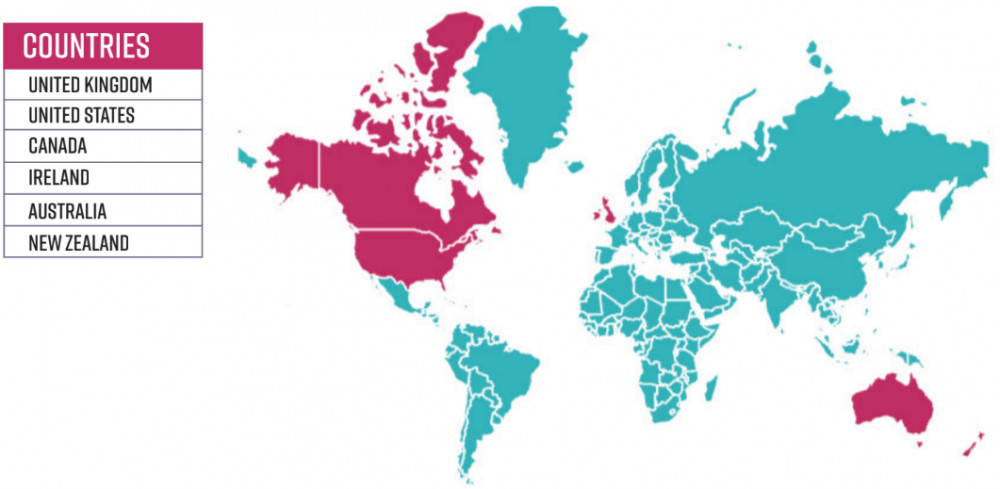





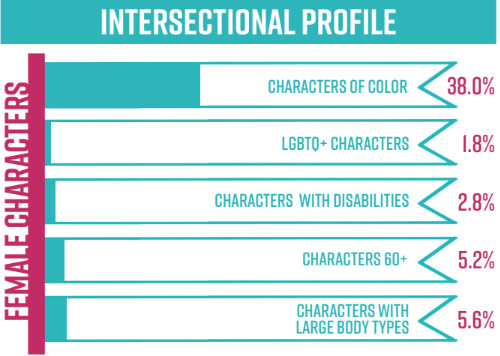

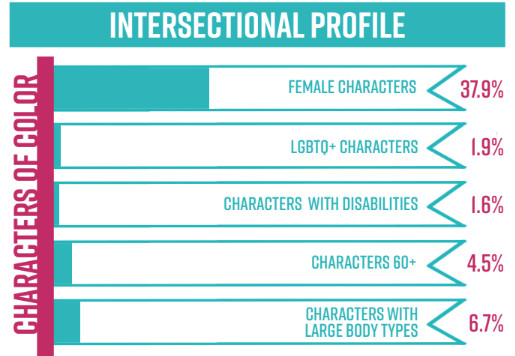

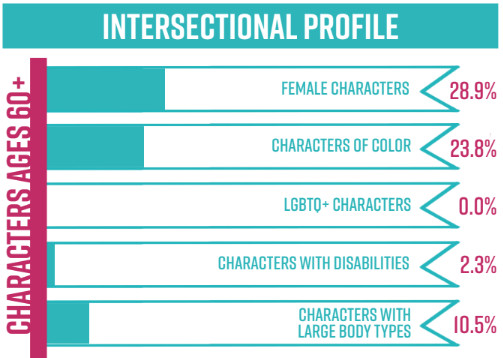

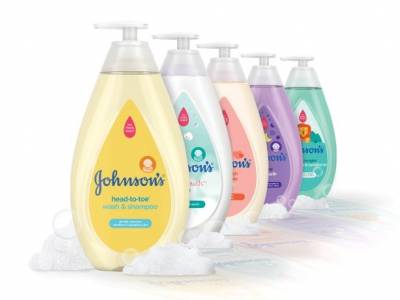



Share
Facebook
YouTube
Tweet
Twitter
LinkedIn